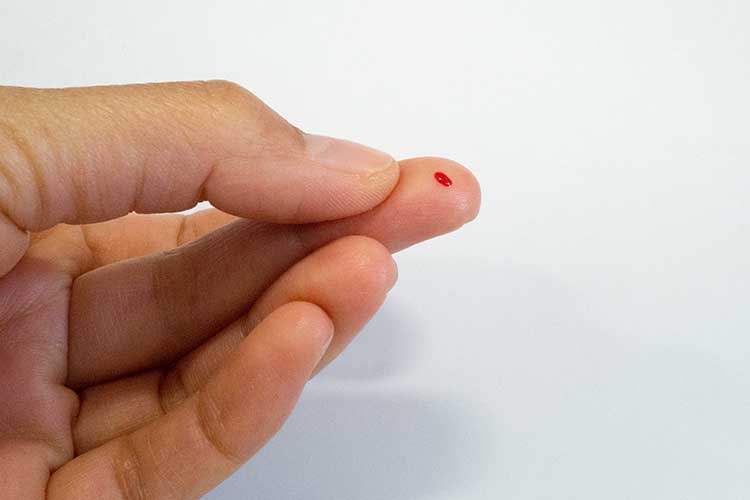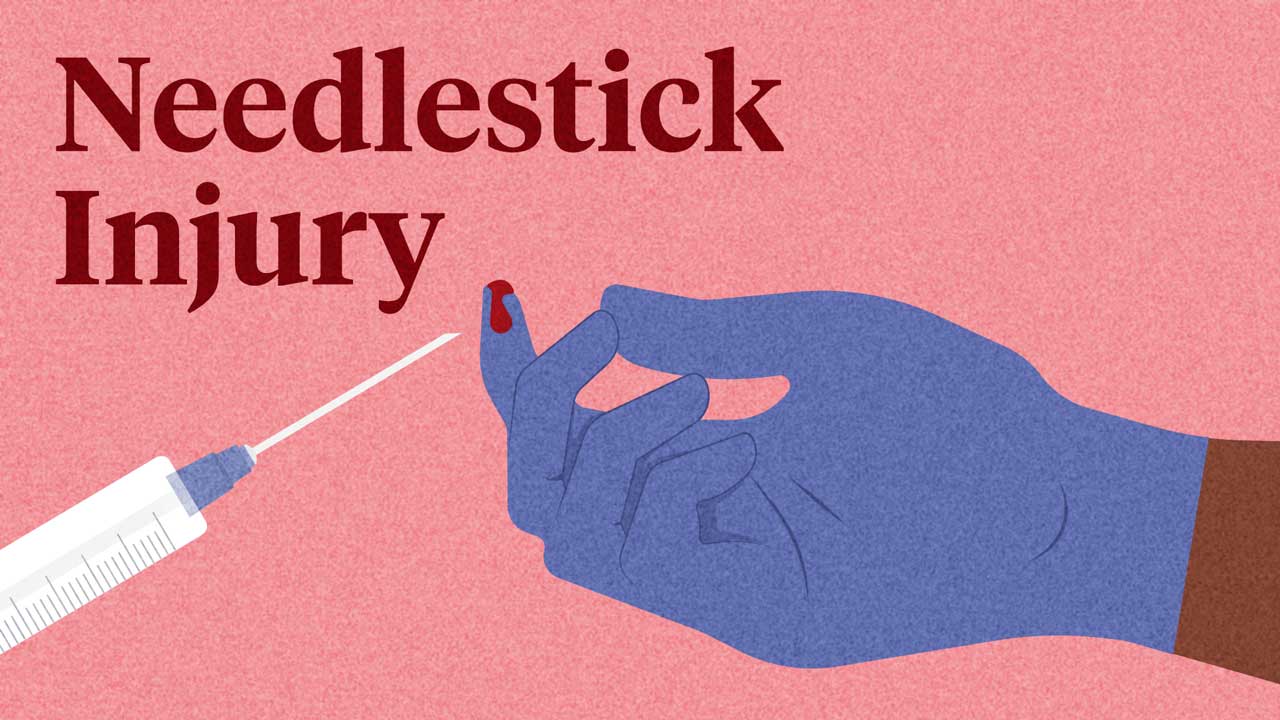Needlestick injuries have the potential to be devastating events. Despite this, they are almost entirely preventable (King & Strony 2023).
In Australia, at least 18,000 healthcare professionals experience a needlestick injury every year (MTAA 2014).
So, how can you protect yourself in the workplace?
What is a Needlestick Injury?
A needlestick injury occurs when the skin is accidentally punctured by a sharp medical instrument such as a needle, scalpel or syringe (Healthdirect 2024).
Needlestick injuries are an occupational hazard for healthcare workers as they can lead to the transmission of bloodborne infections such as human immunodeficiency virus (HIV), hepatitis B and hepatitis C, with the potential for serious complications (King & Strony 2023).
Other infections that can potentially be transmitted via a needlestick injury include malaria, infectious mononucleosis, diphtheria, herpes, tuberculosis and syphilis (MTAA 2014).
How do Needlestick Injuries Occur?

Healthcare workers are at increased risk of experiencing needlestick injuries compared to other people because they use and are exposed to needles and other sharp instruments in their day-to-day work (King & Strony 2023).
Needlestick injuries in healthcare can occur during tasks such as:
- Administering injections
- Opening vials or ampoules
- Disassembling needle kits
- Opening and recapping needles
- Performing surgical procedures
- Performing procedures that involve intravenous or major vessel lines
- Disposing of needles and sharps
- Venepuncture
- Using scalpels
- Intravenous cannulation
- Screening for blood glucose and haemoglobin.
(MTAA 2014)
It’s important to note that sharps do not need to be freshly contaminated in order to transmit infections; objects carrying dry blood can also lead to disease transmission (MTAA 2014).
Management of a Needlestick Injury
Note: The procedure for managing a needlestick injury will vary between workplaces. Always refer to your organisation’s policies and procedures.
If you experience a needlestick injury, you should:
- Immediately wash the wound with running water and soap and remove any contaminated clothing. If your eyes, nose, or mouth come into contact with bodily fluids, flush them with water and saline.
- Treat the wound as required.
- Apply an antiseptic and clean dressing to the wound.
- Notify relevant personnel in your workplace (e.g. your supervisor). The incident will need to be documented. Your organisation may have specific reporting guidelines for needlestick injuries. Ensure you are familiar with and follow all local policies and procedures.
- Seek immediate medical treatment. This might include testing for HIV, hepatitis B virus (HBV) and hepatitis C virus (HCV), post-exposure treatments, and counselling.
(CDC 2021; Practice Assist 2020; Healthy WA 2025; VIC DoH 2015)
Following a needlestick injury incident, both you and the patient from whom the needle or sharp originated will be advised to be tested for HIV, HBV and HCV (Better Health Channel 2014; Practice Assist 2020).
Depending on the results of these tests, as well as your hepatitis B immunisation status, you may be offered hepatitis B immunoglobulin and/or post-exposure prophylaxis for HIV (King & Strony 2023).
Note that no vaccine or post-exposure prophylaxis is currently recommended for HCV exposure (PCH 2021).
If the source patient of the needle or sharp is negative for these pathogens, no further action usually needs to be taken. If the source patient tests positive for one of these pathogens and you test negative, you may need to undergo repeat testing (Bowden 2001).
Note that each case will require assessment by a medical practitioner for specific and individualised management.
What is the Risk of Infection From a Needlestick Injury?
It’s important to note that the overall risk of disease transmission from a needlestick injury is low. However, a needlestick injury can still be a traumatic and stressful experience, and affected individuals may feel anxious about the possibility of contracting a chronic infection (King & Strony 2023).
| Bloodborne virus | Risk of infection where the source case has existing infection |
|---|---|
| HIV | 0.3% |
| Hepatitis B | 30% |
| Hepatitis C | 3% |
(PCH 2021)
Preventing Needlestick Injuries

Healthcare workers can reduce the risk and severity of a needlestick injury by:
- Avoiding using needles if safe and suitable alternatives are available, such as needleless IV connectors and prefilled syringes
- When needles are required, using only devices with safety features such as guards or retractable ends
- Avoiding recapping needles
- Avoiding bending or snapping needles
- Planning how to safely handle and dispose of needles before using them
- Immediately disposing of sharps in conveniently placed and appropriate sharps disposal bins
- Ensuring sharps disposal containers comply with Australian standards (e.g. with a wide neck to avoid the need to force objects in)
- Avoiding overfilling sharps containers
- Telling their supervisor about any needlestick hazards or near-misses they observe
- Undergoing infection prevention training
- Getting vaccinated for hepatitis B
- Always following workplace safety procedures.
(CDC 2021; Better Health Channel 2014)
Conclusion
Needlestick injuries are a significant occupational hazard for healthcare staff and can result in physical and psychological distress. However, they are preventable. Preventative measures such as the implementation of safe work practices and the provision of education and training can help reduce incidences.
Test Your Knowledge
Question 1 of 5
What is the first step you should take in the event of a needlestick injury?
Topics
Further your knowledge
 Free
Free Free
Free Free
Free Free
Free Free
FreeReferences
- Better Health Channel 2014, Needlestick Injuries, Victoria State Government, viewed 14 March 2025, https://www.betterhealth.vic.gov.au/health/conditionsandtreatments/needlestick-injury
- Bowden, FJ 2001, ‘Needle-Stick Injuries in Primary Care’, Aust Prescr., vol. 24, no. 4, viewed 14 March 2025, https://www.nps.org.au/australian-prescriber/articles/needle-stick-injuries-in-primary-care
- Centers for Disease Control and Prevention 2021, Needlestick Injuries are Preventable, U.S. Department of Health & Human Services, viewed 14 March 2025, https://archive.cdc.gov/#/details?url=https://www.cdc.gov/niosh/newsroom/feature/needlestick_disposal.html
- Department of Health 2015, Managing Exposures to Blood and Body Fluids or Substances, Victoria State Government, viewed 14 March 2025, https://www.health.vic.gov.au/infectious-diseases/managing-exposures-to-blood-and-body-fluids-or-substances
- Healthdirect 2024, Needlestick Injuries, Australian Government, viewed 14 March 2025, https://www.healthdirect.gov.au/needlestick-injuries
- Healthy WA 2025, Treating Needlestick Injuries, Government of Western Australia, viewed 14 March 2025, https://www.healthywa.wa.gov.au/Articles/S_T/Treating-needlestick-injuries
- King, KC & Strony, R 2022, ‘Needlestick’, StatPearls, viewed 14 March 2025, https://www.ncbi.nlm.nih.gov/books/NBK493147/
- Medical Technology Association of Australia 2014, Use of Safety-Engineered Medical Devices (Semds) to Improve Prevention of Needlestick And Sharps Injuries in the Healthcare Setting, MTAA, viewed 14 March 2025, https://www.mtaa.org.au/sites/default/files/uploaded-content/website-content/Sharpsv5.pdf
- Perth Children’s Hospital 2021, Needlestick Injury, Government of Western Australia, viewed 14 March 2025, https://pch.health.wa.gov.au/For-health-professionals/Emergency-Department-Guidelines/Needlestick-injury
- Practice Assist 2020, How to Manage a Staff Needlestick Injury, Practice Assist, viewed 14 March 2025, https://www.practiceassist.com.au/PracticeAssist/media/ResourceLibrary/General%20Practice%20Accreditation/Staff-Needlestick-Injury-Poster-V2-200929.pdf

